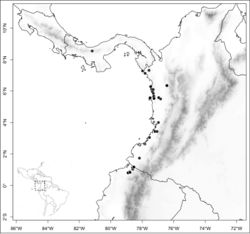Conostegia dentata
| Notice: | This page is derived from the original publication listed below, whose author(s) should always be credited. Further contributors may edit and improve the content of this page and, consequently, need to be credited as well (see page history). Any assessment of factual correctness requires a careful review of the original article as well as of subsequent contributions.
If you are uncertain whether your planned contribution is correct or not, we suggest that you use the associated discussion page instead of editing the page directly. This page should be cited as follows (rationale):
Citation formats to copy and paste
BibTeX: @article{Kriebel2016PhytoKeys, RIS/ Endnote: TY - JOUR Wikipedia/ Citizendium: <ref name="Kriebel2016PhytoKeys">{{Citation See also the citation download page at the journal. |
Ordo: Myrtales
Familia: Melastomataceae
Genus: Conostegia
Name
Conostegia dentata Triana – Wikispecies link – Pensoft Profile
- Conostegia dentata Triana, Trans. Linn. Soc. London 28: 99. 1872. Type: Colombia. Chocó: J. Triana 4113 (not seen-see discussion for details on the type).
- Conostegia hispida Gleason, Bull. Torrey Bot. Club 66: 415. 1939. Type: Ecuador. Esmeraldas: Playa Rica, Parroquia de Concepción, 105 m, 10 December 1936, Y. Mexía 8430 (holotype: NY!, isotypes: BM, F, GH, MO!, NA, S, UC, US!).
Description
Shrub to small tree 1.3–8 m with sub-terete stems that are densely setose with simple bristles up to 4 mm long; the nodal line hard to see and covered with setae as the rest of the node and internode. Leaves at a node equal to sub equal in size. Petiole 0.5–4.9 cm long. Leaves 11.9–35 × 5–12.9 cm, 3–5 plinerved, with the innermost pair of veins arising up to about 3 cm above the base and diverging mostly in opposite or sub opposite fashion from the mid vein, obovate to nearly elliptical, the base acute to decurrent on the petiole and with paired formicaria ca. 2–4 cm long on the leaf surface or extending to the petiole, the apex rounded to obtuse and abruptly acuminate, the margin dentate, undulate-dentate or denticulate, adaxially sparsely setose, abaxially setose. Inflorescence a terminal compact panicle 1.5–4(-7) cm long, inflorescence rachis obscured by the dense setose indument; bracts and bracteoles 1.5–4 mm. Pedicel ca. 2 mm long, obscured by the indument. Flowers (5-)6(-8) merous, calyptrate. Flower buds ca. 9–15 × 5–7 mm, narrowly ovate not constricted about the middle, rounded a the base, acute and long attenuate at the apex, not constricted in the middle, the calycine and hypanthial portions undifferentiated; the hypanthium 5–6.25 × 5.5–7.5 mm, densely hirsute with trichomes with swollen bases. Petals ca. 9–13 × 9–12 mm, white or pink, obtriangular, spreading, glabrous, the apex emarginate. Stamens 19–30, ca. 7–8 mm long, their posture at anthesis not seen, the filament 4–5 mm long, lacking a conspicuous geniculation, anther 2.8–3.5 mm, linear-oblong, recurved near the base, yellow, laterally compressed, the connective thickened and with a small bump dorsally, the pore ca. 0.1 mm, subterminal and slightly ventrally inclined. Ovary 6–10 locular, inferior, the apex glabrous and forming a collar around the style base. Style 6.5–7.5 mm long, gently curved, vertical distance from the anthers to the stigma ca. 1–2 mm, horizontal distance absent, the stigma sub capitate, ca. 1.3 mm wide. Berry ca. 7 × 7 mm when dry. Seeds not seen.
Distribution
(Fig. 119). Ranging from Panama to Colombia and Ecuador on the Pacific coast, 0–680 m in elevation. Conostegia dentata is easily recognized because of its setose indument on stems, inflorescences and flower buds, leaves with formicaria at the base and dentate margins, and compact inflorescences. The study of flowers in herbarium specimens revealed an exserted style as is typical of species of section Australis. Almeda (2009)[1] was unable to locate the type specimen Triana 4113 of this species at BM and when checking Triana’s herbarium list noted that that number is stated to be from Antioquia instead of Chocó, but no genus or species are stated. Almeda did locate Triana 4112 which corresponds to Conostegia dentata but that specimen is from Barbacoas province instead of Chocó province where Triana 4113 was cited to have been collected. I agree with Schnell (1996)[2] that the original description leaves little doubt on its identity namely because of the description of the setose indument, congested inflorescences and long petals. Because the setae of the fruiting hypanthia are white instead of brown as in the rest if the plant, Schnell (1996)[2] hypothesized that this color difference might function to attract dispersal agents.
Specimens examined
PANAMA (fide Schnell). Darién: Cocalita near the Colombian border on the Pacific side, Dwyer 4395 (BR, GH, UD); Atlantic slope NW of Santa Fe, 11 km from Escuela Agricola Alto de Piedra, in valley of Rio Dos Bocas, Mori and Kallunki 3850 (US).
COLOMBIA. Cauca: Costa del Pacífico, río Micay, orilla derecha, en Caliche, Cuatrecasas 14190 (NY). Chocó: Mun. Nuqui, Corregimiento Termales, Quebrada Piedra Piedra, Acevedo-Rodríguez, Callejas and Churchill 6800 (NY); Río Mutatá tributary of Río El Valle between base of Alto de Buey and mouth of river, Gentry and Fallen 17474 (MO, NY). El Valle: Costa del Pacífico, río Cajambre, Barco, Cuatrecasas 17143 (NY, US); Costa del Pacífico, río Cajambre, San Isidro, Cuatrecasas 17280 (NY); Costa del Pacífico, río Cajambre, Silva, Cuatrecasas 17668 (NY); Colorado, north shore of Buenaventura Bay, Killip 38772 (NY). Nariño: Quebrada Mongon at Camp Mongon, Río Telembi above Barbacoas, Ewan 16877 (NY).
ECUADOR. Esmeraldas: Eloy Alfaro, Reserva Ecológica Cotacachi-Cayapas, Río Santiago, Tirado 571 (MO, NY).
Taxon Treatment
- Kriebel, R; 2016: A Monograph of Conostegia (Melastomataceae, Miconieae) PhytoKeys, (67): 1-326. doi
Images
|
Other References
- ↑ Almeda F (2009) Melastomataceae. In: Davidse G Sousa-Sánchez M Knapp S Chiang F (Eds) Flora Mesoamericana (vol. 4). Universidad Nacional Autónoma de México, 164–338.
- ↑ 2.0 2.1 Schnell C (1996) The Genus Conostegia (Melastomataceae). PhD thesis, Harvard University.
